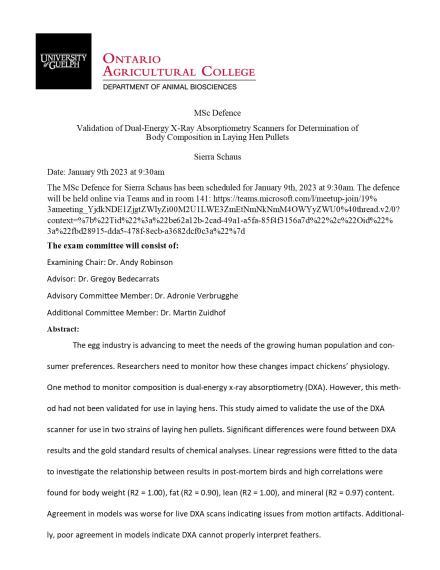Sierra Schaus' MSc Defence
Date and Time
Location
Room 141 and teams: https://teams.microsoft.com/l/meetup-join/19%3ameeting_YjdkNDE1ZjgtZWIyZi00M2U1LWE3ZmEtNmNkNmM4OWYyZWU0%40thread.v2/0?context=%7b%22Tid%22%3a%22be62a12b-2cad-49a1-a5fa-85f4f3156a7d%22%2c%22Oid%22%3a%22fbd28915-dda5-478f-8ecb-a3682dcf0c3a%22%7d

Details
Validation of Dual-Energy X-Ray Absorptiometry Scanners for Determination of Body Composition in Laying Hen Pullets
The egg industry is advancing to meet the needs of the growing human population and consumer preferences. Researchers need to monitor how these changes impact chickens’ physiology. One method to monitor composition is dual-energy x-ray absorptiometry (DXA). However, this method had not been validated for use in laying hens. This study aimed to validate the use of the DXA scanner for use in two strains of laying hen pullets. Significant differences were found between DXA results and the gold standard results of chemical analyses. Linear regressions were fitted to the data to investigate the relationship between results in post-mortem birds and high correlations were found for body weight (R2 = 1.00), fat (R2 = 0.90), lean (R2 = 1.00), and mineral (R2 = 0.97) content. Agreement in models was worse for live DXA scans indicating issues from motion artifacts. Additionally, poor agreement in models indicate DXA cannot properly interpret feathers.